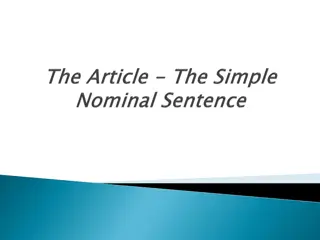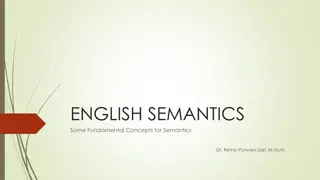Exploring Arabic Semantics in Linguistics by Amir Abbas Mayouf
The article delves into the Arabic perspective in semantics as studied by linguists like Amir Abbas Mayouf. It discusses the definition of semantics, the difference between semantics and meaning, and the role of semantics in language sciences. The linguistic context, lexical reference, and phonetic reference in semantics are highlighted to understand how meaning is conveyed in Arabic language structure.
Download Presentation

Please find below an Image/Link to download the presentation.
The content on the website is provided AS IS for your information and personal use only. It may not be sold, licensed, or shared on other websites without obtaining consent from the author. Download presentation by click this link. If you encounter any issues during the download, it is possible that the publisher has removed the file from their server.
E N D
Presentation Transcript
Arabic Perspective in Semantics Amir Abbas Mayouf
Definition of Semantics So many Arab linguists tried a lot to define "semantics and meaning" as a branch of linguistics. 1-Some used semantics to serve meaning, where they noted that it is the science that studies the conditions to be provided in the linguistic symbol in order to be able to carry meaning. 2-Others hired the meaning to serve semantics, where they stressed the significance of overt semantics on the hidden meaning. 3-The others have defined it as the branch of linguistics that tries to study the changes in the meaning through the analysis of linguistic structure, phonetically, morphologically, lexically and syntactically, taking into account the shift in usage over time.
The Difference between Semantics and Meaning: Many definitions were put to Semantics and Meaning. Some say it is Semantics, others say the science of Meaning, while some others say /?assimantik/, from the English word Semantics. Most of the definitions did not differentiate between the two terms - Semantics and Meaning- as there are who say: "Semantics or Meaning is defined as ... ,"using the conjunction "or" which means choice, and indicates that there is no scientific basis for the two different terms to differentiate between them. If there is a difference between Semantics and Meaning, it is an artificial one just to discover the role played by the utterance in sentences and in context. Arab Linguists found that meaning changes in accordance to the change of the word position in a sentence, and that this change has nothing to do with synonymy, but brings us back to the development of semantics and use.
Semantics and Language Sciences: To determine the meaning of the verbal action, the speaker must observe linguistic relations as well as adequate experience of the listener/hearer to convey the appropriate meaning. Linguistic reference (semantics) is divided into four sections: 1. Lexical Reference : Lexical words carry the original meaning of any word before witnessing any changes to language words or any increase in the need to attract new meaning to some of the old words. "Dictionaries" which means /ma ajim/ in Arabic contain the meanings of the words without noting the changes that were intercepted in the previous period, which is of course subject to change ,as in / anab/ that originally means "whiteness and sparkle" in dictionaries, while in use means moustache ,and / awiil ?alyad/ that means in dictionaries ,"long hand" which is a "personal character that shows generosity and good decent", while in use the "thief" "and length of hand" mean theft.
2. Phonetic Reference Arab linguists and semanticists divided phonetic reference into two categories: First, phonemes that distinguish a word from another, as in/ adda/ and /sadda/ that mean "repel" and "closed", taking into account that the pronunciation of the two phonemes /s/ and / / are easier than / /and /x/ ,and it is easier to utter the word / adda/ rather than the word /sadda/ due to the place of articulation of / / and /d/./ adda/ conveys strength and power, while /sadda/ conveys ease and convenience. We say: / adda ?aljunudu hujuma ?al ?a da?/ , which means "The soldiers repulsed the enemy's attack", and say: / sadda ?alwaladu ?albab/ , which means "The boy closed the door". Second, tone and intonation that give significance to any utterance, such as the verse in the Holy Qur'an: /ma ?a na anhu maluhu wama kasab/( Al-Masad, 2 ), which means "His wealth and gains will not exempt him".Without toning voice or punctuation mark in reading or writing, we will not grasp the true meaning . For we cannot know the exact meaning of /ma/ whether it is a question or negation. 3. Morphological Reference To discern the meaning of the words /?ista far/ and /?istan ar/ which mean "ask for forgiveness" and "ask for help" respectively , it is not enough to look up the word in a dictionary, but must look for the formula -/?alif/, /siin/ and /tah/- that means demand.
4. Syntactic Reference Syntax specializes in the organization of words in sentences, and studies the structure of the sentence. It is known that Arab linguists divided speech into/?ism/ and /fi l/ and / arf/ which mean "noun ,verb and letter", and made clear attributes of each and every one of them. If we say / akara musa isa?/ that means "Mousa thanked Issa" , this means that Mousa must be the "thankful" not Issa as it is the order of the verb phrase. We can conclude that syntax and semantics complement each other as we cannot understand the connotation of the sentence without both of them. An important question now is what we mean by the temporal evolution of the word? No one disagrees on the change in the use of words of language from time to time , and so Arab linguists tried to limit this amendment and the shift in meaning , so they monitor some colloquial words as /jaba/ which means "brought" . Linguists believe that the verb was coined from /ja?a bika a/ which means "came with something", as the letter /ba/ was considered the end of the verb.
Types of Meaning : 1-Initial Meaning : It is also called the primary, conceptual or cognitive. It is the chief means of linguistic communication.This type of meaning should be the common denominator between the speaker and listener or hearer. For example , it is known that /?imra?ah/ which means "woman 2-Secondary Meaning It is also called additional or accidental. This type of meaning is implicated in the word and its initial meaning and has no constancy and inclusiveness, but changes with the culture and experience. For example, /?imra?ah/ could mean (+?insan ,+jamal, +riqqah, + a ifah ) which means a "woman" that is: (+human, +beauty, +tenderness,+emotion).
3. Stylistic Meaning This kind of meaning reveals the social conditions and status of the user of the language, other levels such as specialization, the degree of relationship between the speaker and the listener/hearer and the rank of language being slang, literary, formal, and the type of language being poetry, prose, and whether it is speech or writing. 4. Psychological Meaning This type of meaning includes the words and their references and connotations for the individual which could be the speaker or the listener/hearer. This type cannot be generalized among a certain society. For example /zawjah/ which means "wife" could have a different meaning, when a man living a stable family life with his wife that believes in love and cooperation, and another man in another family with a wife that represents lack of cooperation, thus this kind of meaning affects the secondary types of meaning 5. Connotative Meaning This type of meaning is concerned with words of high ability to suggest and indicate some voices such as / aliilu ?assuyuuf/ , /muwa?u ?alqi ah/, which mean "rattle of swords" ,"cat's meow .
Semantic Components Language is based on two essential elements "utterance and meaning", and their close association as if we know the word (utterance)we understand its meaning, thus we note three things : 1. Signifier (?addal):any utterance or utterances which are structured properly . 2. Reference(?almadluul): it is the meaning or idea held by the structure of contexts, or words stored in the minds of the group and have been associated with their own meanings defined by the language dictionaries, or full knowledge of the meanings of the words that people know. 3. Semantic Relation (?al alaqatu ?addalaliyyah): it is the relationship between the utterance and its meaning , and depends significantly on the type of speech , the linguistic conditions , and the relationship of the listener/hearer, reader and speaker with the topic talking about, and experience in the meanings of words, as the relationship between word and meaning is complex. Haider ( 2005) states that meaning does change and vary in accordance to linguistic situations, changing social aspects from time to time in individuals or groups, which requires renewal as some words and utterances could vanish and die and be replaced by others .
The Relationship between Signifier and Reference The relationship that joins the signifier with the reference is the semantic relation, but how do we disclose this relation? This disclosure is based firstly on the condition of the speaker, and listener/hearer secondly; or the writer and the reader as the former must meet the adequate culture and should distinguish between high class words and utterances and inappropriate ones, and the second must be of vast experience. The question that could be raised -is this relationship the same as in colloquial Arabic which we use now a days? This semantic relation descends dramatically in present colloquial that we use, as it is replaced by the current knowledge of words and their meanings, with little role for this relation. If we underscore the colloquial among the public but not among the intellects and cultured, we will notice that the semantic relation is very clear. The public's words are not based on the knowledge of the relationship between word and meaning, but depend mainly on national or geographic basis. This basis is due to present time period that pervaded different colloquial and moved away from its ancient origins (Anees, 1980). He says that the Egyptian, for example, who uses the verb /bu / which means " look" may not know that this verb originally means "What is striking because of its luster and shine". When we say in our Jordanian colloquial /taxbii / which means "lying, slander or lack of understanding", most of us would not know that this word means mixing and blending things together. Saleh (2003) mentioned / ariim/ which means "women", was originally used for things that are not allowed or deprived to touch, so the relation between the signifier and the reference (signified) in the colloquial is a very small and limited as it is based on the primary and abstract meaning.
Features of Semantic Development 1.Generalizing Specific Reference This type of generalization is used when using the word that signifies an individual or a particular kind of gender to indicate many individuals or the whole race. For example, the word /?alqawm/ which means "a group of people", was used to mean men only, then was expanded to include men and women. 2. Specifying General Reference There were so many words that have had broad and public connotations but were narrowed and became limited and so moved from general reference to specific ones. For example, the word /?al aj/ which means /ziyarah/ in Arabic and "a visit" in English . Islam then made certain rites and rituals for/ aj/ which is "visiting the Sacred Mosque in Mecca at a certain time of the year"
3. Semantic Transition This form of Semantic change depends on a metaphorical relationship that could be a similar relationship through metaphor that is using the word in non-original meaning as of the existence of this relationship, and could be a non-similar relationship that comes through metonymy. This type of un real meaning is called metaphorical or transferred meaning. An example of transition of connotation because of similar relationship is /bayt/ to mean "house" then /baytu ?a a r/,"tent of the Bedwins". Another example of transition of connotation as a result of non similar relationship is /?assama?/ which originally means "the sky", but later is used to mean "rain" (Haider, 2005 ; Saleh, 2003)
Reasons for Semantic Development 1. Need Users of the language resort to classical words that they remember their connotations and use them with modern inventions and discoveries. This means that they have been using words of an old gloss with modern meanings, and therefore the meaning changed. For example,/assayyarah/,which they mean "car . This word is used now differently , and this process is done usually by bodies and language academies or some talented individuals as poets and writers . Some of these words are accepted and become familiar and others disappear from use. Some others may be widely used that people forget the old meaning of the word as in /?assayyarah/ which originally means the convoy in the desert. 2. 2. Social and Cultural Reasons The evolution of social life produces a new gloss on the words and their connotations. This is clear in the following pictures: a. The form of transition from semantic sensory to semantic abstract as a result of the evolution of the human mind. b. b. The form of an agreement between a "group" of different cultures to use words of specific semantic features defined in line with the things and experiences and concepts appropriate to their new culture such as some religious words, as in /?a alah/,which originally means/du a?/ ,"prayer", was modified to mean performing certain rites five times a day in accordance to Islamic Sharia . c. c. The form of using old words and their meanings on modern connotations as it is felt they denote the same job or meaning despite the difference in shape. /safinah/ for example , which is a" ship" that has not changed although existing ships nowadays are different from old ones
3. Emotional and Psychological Feelings Languages prohibit the use of certain words because of their unacceptable connotations, or explicit significance on what bothers .This led of course to the change of word connotations as in words of filth and phrases related to sex. It is noted that all languages lose some of their words that reflect these aspects and are replaced by less obvious words in their connotations and more obscure or blinding. 4. Linguistic Deviation Speakers of the language sometimes deviate the use of certain words to mean a relative or similar meaning which is a matter of metaphor, or may be a deviation resulted from misunderstanding or confusion or ambiguity. The word /?almaktabah/ which means "library", could mean to others "bookshop . 5.Metaphoric Transition Speech is divided into: (real and metaphorical). Real means "the original denotation of the word" and the first inserter of the language is responsible for it; and metaphorically means "the other meaning that is not set in the origin of language". Linguists divided words to real and metaphorical. Some believe that words are real and true, and some see that they are all metaphors, and some consider them to be true and metaphoric at the same time. Only the hearer/listener can judge the truth and metaphoric meaning because the truth is widely used and is familiar, while metaphor is a deviation from the usual and common. An example of this is /ha ama ?a alibu ?addars/, a sentence that is always used by school teachers, which means "the student understood the lesson". This sentence is deviated from its original utterance /ha ama ?a alibu ?a a am/ which means "the student digested the food" , and is used metaphorically to mean understanding the lesson .
6. Historical Reasons The transition of language from the past to present causes changes in the meanings of words which either narrows the meaning or expands it , or even changed to dislocate any relation between the new meaning and the old one , as connotations are in a growth and development through time. An examples is /zindiiq/ , a "heretic", which is in Persian "the person who studied the book of Zoroaster", but this word changed to indicate the agnostic departure from the Islamic religion in gener. 7. Innovation Innovation is a reason for changing the meaning, and is mainly performed by two types of people: a. The gifted who are the poets and writers, and the need to clarify the semantic meaning or to strengthen its impact in mind oblige them to resort to innovation . b. Language academies and scientific bodies, where there is a need to use a word to express a certain idea or concept, and this creates a new meaning























